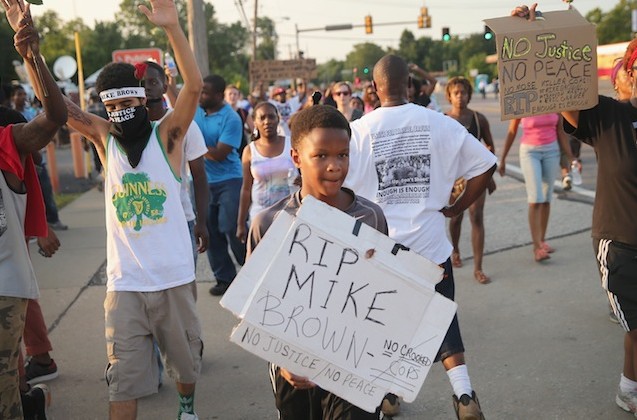I’ve got multiracial coalition on the mind today and so, clearly, do others. As Deepa Iyer wrote for The Nation, non-black people of color have a stake in the search for justice for Michael Brown.
But, efforts to move non-black people of color by reminding them of their own horrid experiences with the cops only have so much power. As Soya Jung, a Korean-American activist, writes for Race Files,
I do not move through the world in the crosshairs of a policing system that has its roots in slave patrols, or in a nation that has used me as an "object of fear" to justify state repression and public disinvestment from the infrastructure on which my community relies. I am not public enemy number one in the ongoing U.S. domestic war over power and resources that has systematically denied black humanity.
Communities of color have unique experiences that should not be equated with one another. People of color in the U.S. all live amidst white supremacy, but not everyone lives as targets of anti-blackness. Jung argues that Asian Americans have three options: "invisibility, complicity, or resistance."
Far from being an academic issue for race nerds to debate, Asian-American business owners in Ferguson are immersed in the conversation in a very real way, and have called for "unity," reports The Daily Beast‘s Tim Mak. Mak’s story was slapped with an inflammatory headline though, which described the looting of stores as "Ferguson’s Other Race Problem."
Asian Americans Advancing Justice-LA executive director Stewart Kwoh took issue with that characterization, and released a statement saying so:
In the coming weeks, we will likely hear stories from Ferguson about ongoing protests by African American community members and allies, similar to the days following the Rodney King beating in Los Angeles. At that time, the media pitted communities of color against one another. We cannot allow this to happen again. This is about dangerous, harmful law enforcement practices and the need to end racially-motivated police practices that target communities of color. The Asian American and Pacific Islander community stands in solidarity with the African American community in this fight.
Meanwhile, The Huffington Post‘s Sam Stein spoke with U.S. mayors of cities where police have killed young men of color in high-profile case. Two said that looking back, heavy police repression in response to community outrage was a mistake which only further incited the community. Besides Ferguson’s aggressively militarized police response, what else was going on in the area before Michael Brown’s shooting set off his aggrieved, outraged community?
As Jamelle Bouie reports for Slate, a whole lot:
Everyone–or at least, every black person–can recall an incident. Everyone can attest to friends and relatives who have been harassed, assaulted, or worse by the police.
Perhaps one of the most disturbing cases was last year’s shooting of Cary Ball Jr., a 25-year-old black student at St. Louis Community College-Forest Park. The official police report is that Ball crashed his car after a high-speed chase, ran away, and aimed his weapon at officers after they confronted him. Witnesses say Ball had thrown his gun to the ground and was walking toward police–hands up–when he was shot and killed with 25 rounds. A federal investigation cleared the officers. Likewise, that February, surveillance video from a casino showed St. Louis police slamming a black man’s head into the bumper of a vehicle, after a dispute over gambling and trespassing. And in March of this year, a videoshowed St. Louis police officers beating a mentally disabled man in his home, after the family called police for help.
What are you reading today on Ferguson? Please share, and we’ll see you back here tomorrow.
